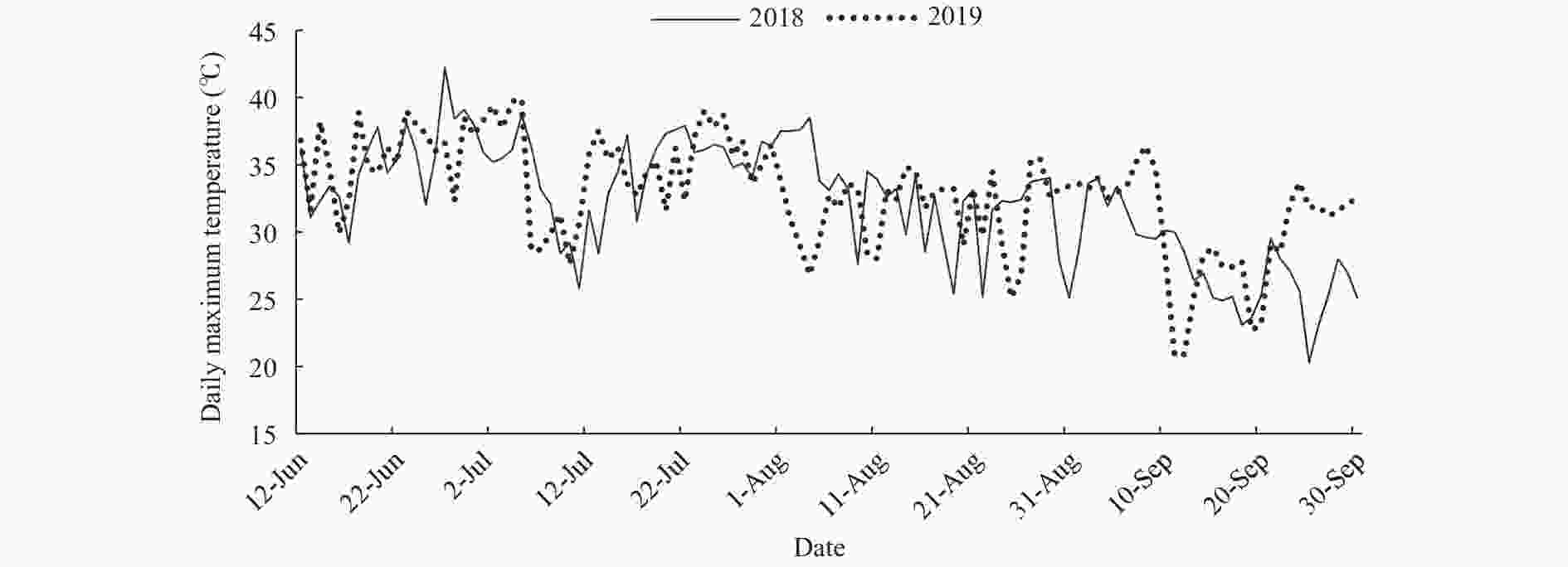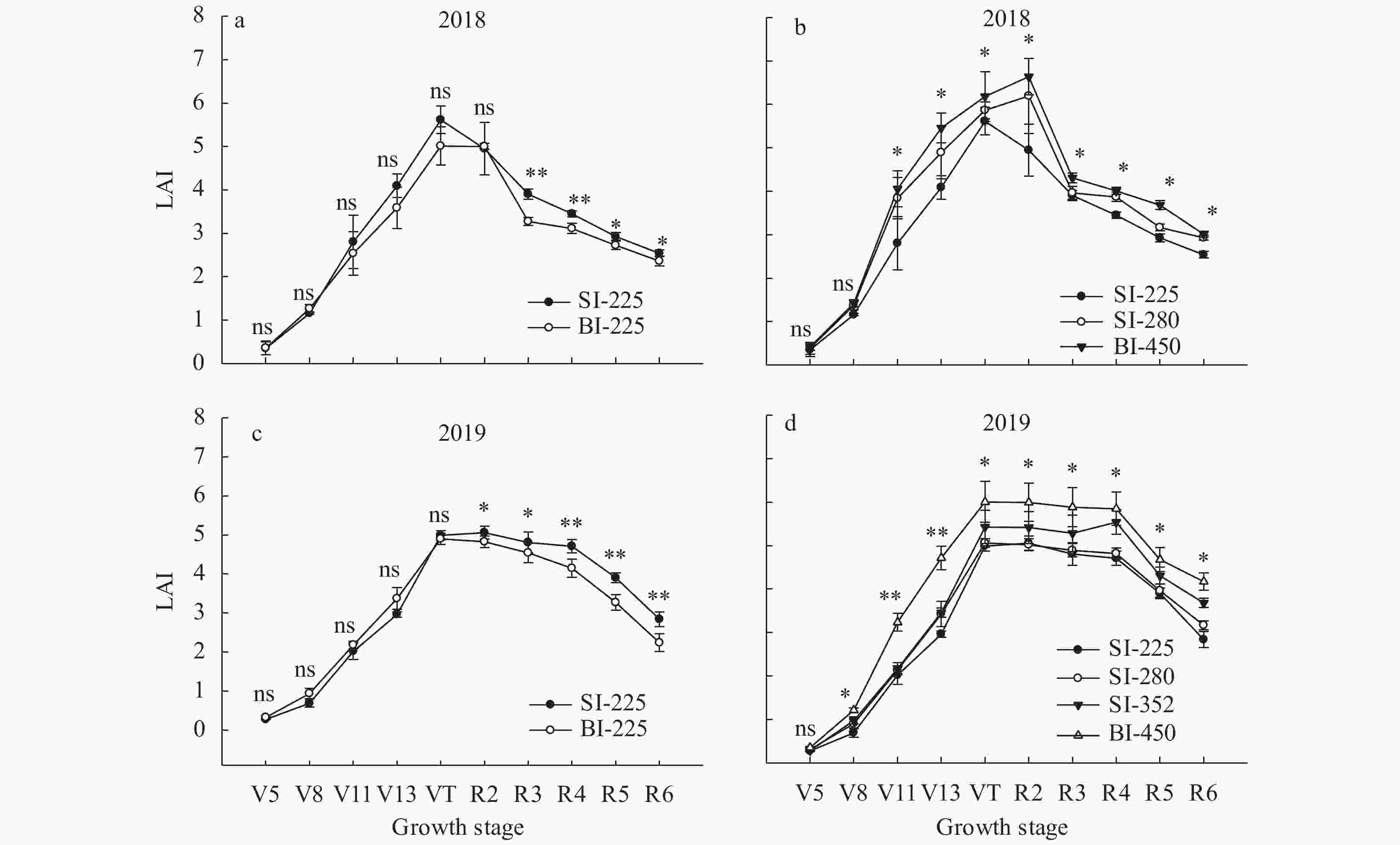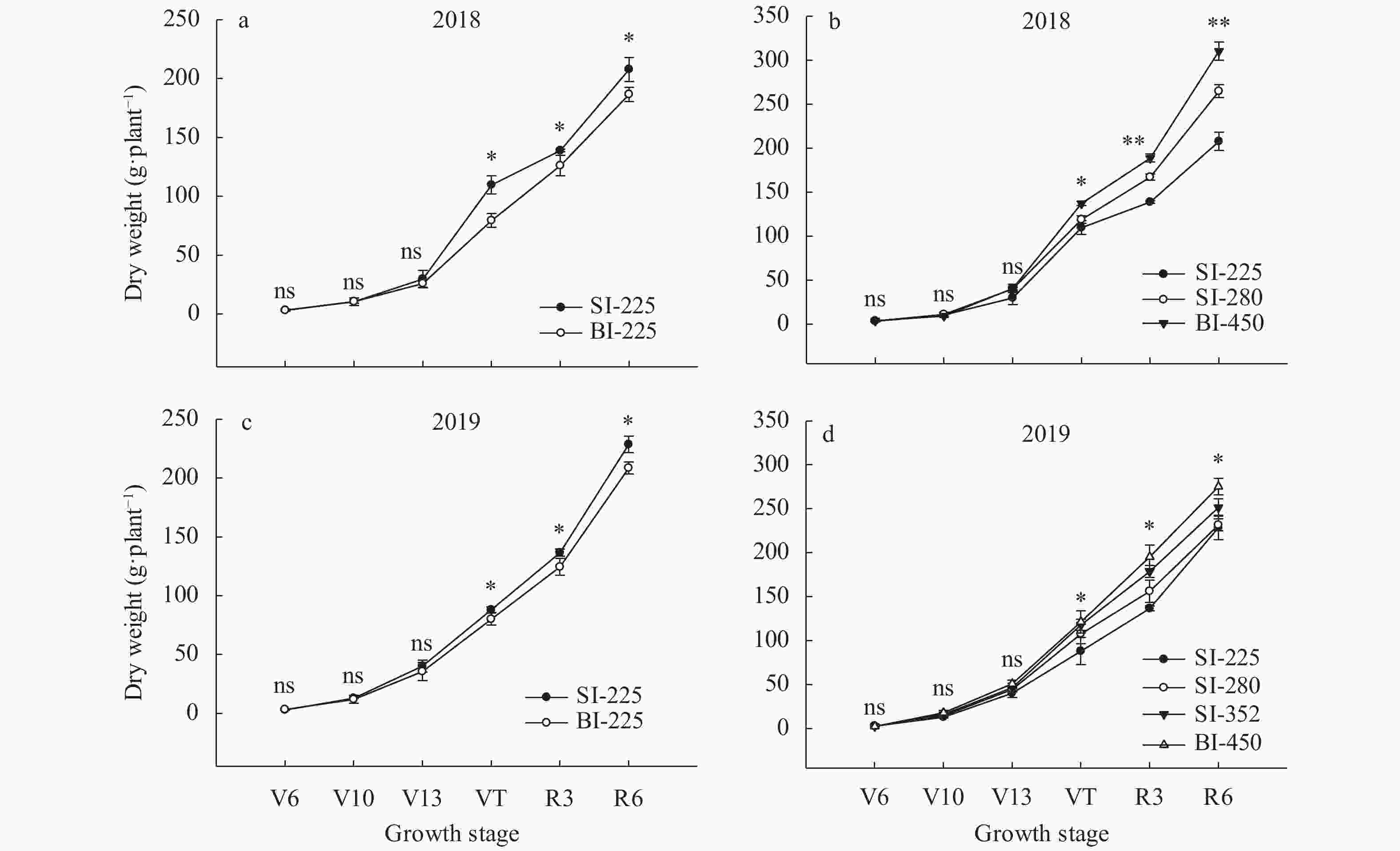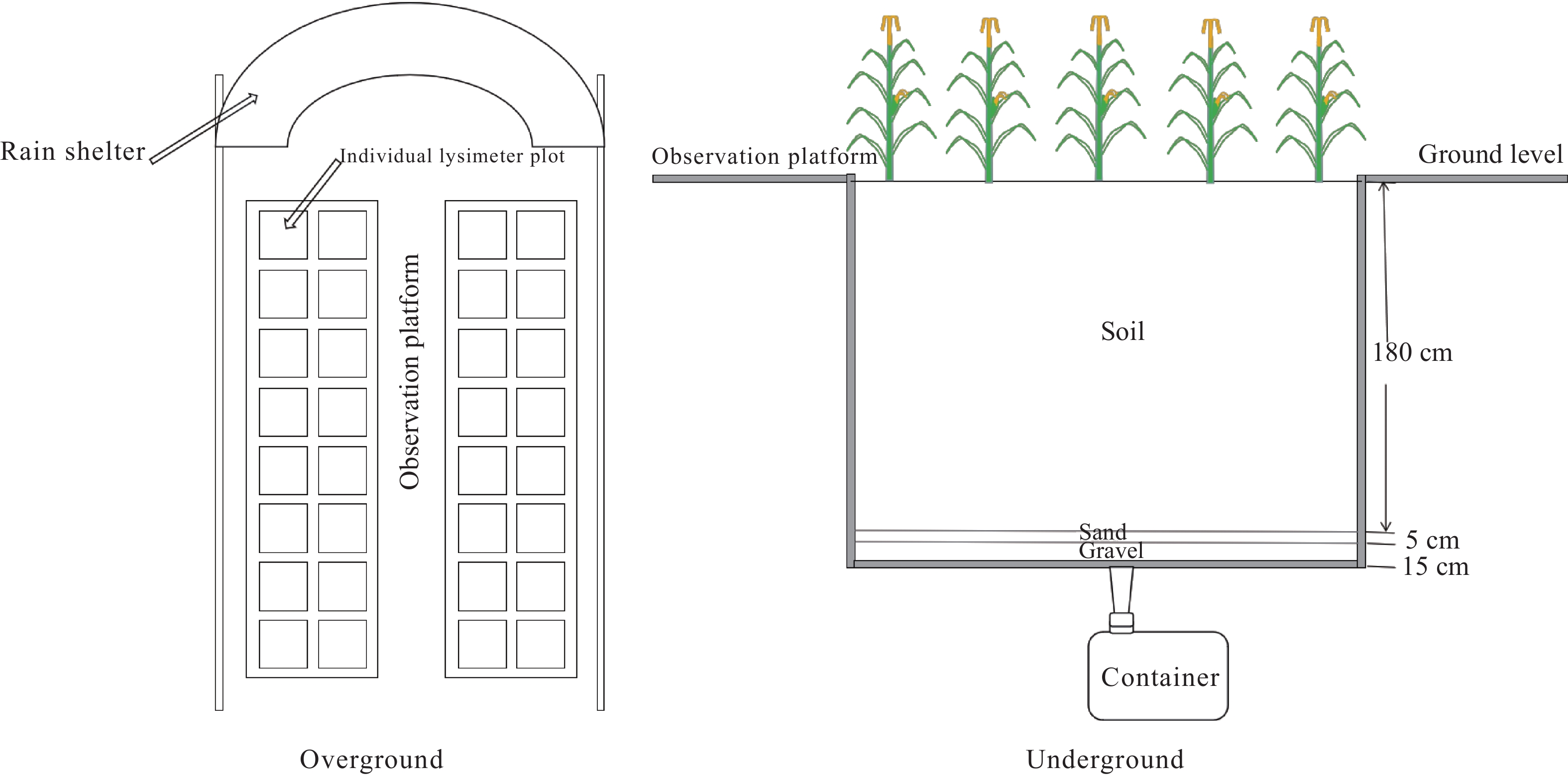Comparison of irrigation strategies for summer maize under deficit irrigation: Grain yield and water use efficiency
-
摘要: 华北平原水资源短缺问题对传统农业灌溉方式提出挑战。限水灌溉条件下调整优化灌水模式是节约灌溉用水、提高水分利用效率(WUE)和作物产量的重要策略。基于此, 本试验在2018—2019年两个生长季, 在自动防雨棚内(消除自然降雨的影响)设置不同灌水模式, 分析其对夏玉米产量和WUE的影响。本试验采用随机区组设计, 设置2种灌水方式: 畦灌(BI)和微喷灌(SI)。根据灌水总额和灌水频次分成2组对比模式。等量不等次组(SI-225和BI-225): 灌水总额相同[50%耗水量(ET)], 灌水频次不同, SI-225灌水频次为6次, 分别在出苗(VE)、6展叶(V6)、10展叶(V10)、13展叶(V13)、吐丝期(VT)和灌浆期(R3); BI-225灌水频次为3次, 分别在VE、V10和VT。等次不等量组(SI-225、SI-280、SI-352和BI-450): 灌水频次相同(6次), 灌水总额不同(分别为50%、60%、80%和100%ET), 其中SI-225和BI-450为定额灌溉, SI-280和SI-352根据土壤墒情进行测墒补灌。结果表明, 与BI-225相比, SI-225产量提高17.7%~20.2%, WUE提高9.2%~12.7%。进一步分析生理指标发现, SI-225通过小定额多次灌溉改善了上层土壤水分状况(0~40 cm), 提高光合速率、叶面积指数和干物质积累, 进而提高产量和WUE。在相同的灌水频次下, 与BI-450相比, SI-225和SI-280产量降低21.2%和12.0%, 但由于SI-225和SI-280降低了叶面积指数和呼吸速率, 导致生育期总耗水量降低, 进而提高WUE。与BI-450相比, SI-352的产量差异不显著(P>0.05), 但SI-352通过优化叶面积指数和呼吸速率, ET降低9.8%, 灌水量降低21.8%, 进而WUE提高5.1%。因此, 在限水灌溉条件下(50% of ET), 通过提高灌水频次(小定额多次灌溉)可提高夏玉米的产量和WUE; 在适度限水灌溉(80% of ET)下, 采用微喷测墒补灌可实现稳产量、高水效。该研究结果可为华北平原缺水地区提高农业用水效率提供理论参考。Abstract: The shortage of water resources in the North China Plain (NCP) poses a challenge to traditional agricultural irrigation methods. Adjusting and optimizing the irrigation mode is an important strategy for saving water and improving water use efficiency (WUE) and crop yield under water-limited irrigation conditions. Given this background, different irrigation modes were set in an automatic rainproof shed (to eliminate the effects of natural rainfall) in the two growing seasons of 2018 and 2019 to analyze the grain yield and WUE of summer maize. In this experiment, a randomized block design was adopted, and two irrigation methods were applied: border irrigation (BI) and micro-sprinkler irrigation (SI). Based on the total irrigation amount and frequency, sample plots were divided into two groups for comparison. Plots in the first group (SI-225 and BI-225) had the same total irrigation amount (50% of evapotranspiration, ET) but different irrigation frequencies. SI-225 was irrigated six times, namely at the emergent seedling stage (VE), sixth leaf stage (V6), tenth leaf stage (V10), thirteenth leaf stage (V13), tasseling stage (VT), and milk stage (R3). BI-225 was irrigated three times at VE, V10, and VT. Plots in the second group (SI-225, SI-280, SI-352, and BI-450) had the same irrigation frequency but different total irrigation amounts (50%, 60%, 80%, and 100% of ET). Among them, SI-225 and BI-450 received a fixed amount of water per irrigation event, whereas SI-280 and SI-352 underwent supplementary irrigation according to their soil moisture content. The results showed that, compared with those of BI-225, the grain yield of SI-225 increased by 17.7%−20.2% and its WUE increased by 9.2%−12.7%. Further analysis of physiological characteristics revealed that SI-225 showed an improved upper soil water status (0−40 cm), increased photosynthetic rate (Pn), leaf area index (LAI), and dry matter accumulation, and consequently higher yield and WUE due to modest but highly frequent irrigation. Under the same irrigation frequency, the grain yields of SI-225 and SI-280 decreased by 21.2% and 12.0%, respectively, compared with that of BI-450. However, total water consumption during the growth period was reduced due to the decrease in LAI and transpiration rate (Tr) of SI-225 and SI-280, which resulted in an improved WUE. The grain yield of SI-352 did not differ significantly from that of BI-450, but its ET decreased by 9.8% due to the optimization of LAI and Tr, its irrigation amount decreased by 21.8%, and its WUE increased by 5.1%. Therefore, under water-limited irrigation conditions (50% of ET), the yield and WUE of summer maize could be increased by increasing the irrigation frequency, with modest but highly frequent irrigation promoting the best results. Moreover, under moderate water limitation (80% of ET), the application of micro-spraying supplementary irrigation based on soil moisture content allowed to achieve a stable yield and a high WUE. These results provide a theoretical reference for improving the efficiency of agricultural water use in water-deficient areas of the NCP.
-
Key words:
- Deficit irrigation /
- Grain yield /
- Water use efficiency /
- Micro-sprinkler irrigation /
- Summer maize
-
Table 1. Irrigation methods, frequencies, amounts per application, and irrigation stages during the growing seasons of summer maize in 2018 and 2019
Year Treatment Irrigation method Irrigation frequency Irrigation amount per application (mm) Irrigation stages Gross irrigation amount (mm) 2018, 2019 SI-225 Micro-sprinkler irrigation 6 38 VE, V6, V10, V13, VT, R3 225 2018, 2019 SI-280 Micro-sprinkler irrigation 6 42, 35, 48, 51, 56, 48 VE, V6, V10, V13, VT, R3 280 2019 SI-352 Micro-sprinkler irrigation 6 50, 47, 60, 64, 81, 50 VE, V6, V10, V13, VT, R3 352 2018, 2019 BI-450 Border irrigation 6 75 VE, V6, V10, V13, VT, R3 450 2018, 2019 BI-225 Border irrigation 3 75 VE, V10, VT 225 VE, V6, V10, V13, VT, and R3 indicate the maize seedling emergence stage, sixth leaf stage, tenth leaf stage, thirteenth leaf stage, tasseling stage, and milk stage, respectively. Table 2. Irrigation stages, monitored soil depth, and standards for determining the supplemental irrigation amount during the summer maize growing seasons of 2018 and 2019
Treatment Index Irrigation stage VE V6 V10 V13 VT R3 Monitored soil depth (cm) 0−40 0−40 0−60 0−80 0−80 0−80 SI-280 SRWC (%) 75 75 80 80 80 75 SI-352 SRWC (%) 80 80 85 85 85 80 SI-280 and SI-352 indicate a total irrigation amount of 280 mm and 352 mm, respectively, using micro-sprinkler irrigation. SRWC indicates the targeted relative soil water content after irrigation, whose value is the percentage of field capacity. VE, V6, V10, V13, VT, and R3 represent the seedling emergence stage, sixth leaf stage, tenth leaf stage, thirteenth leaf stage, tasseling stage, and milk stage, respectively. Table 3. Net photosynthetic rates (Pn) and transpiration rates (Tr) of summer maize before and after irrigation at the thirteenth leaf stage (V13) under different treatments in 2018 and 2019
Year Treatment Before irrigation 7 days after irrigation 14 days after irrigation Pn [μmol(CO2)∙m−2∙s−1] Tr [mmol(H2O)∙m−2∙s−1] Pn [μmol(CO2)∙m−2∙s−1] Tr [mmol(H2O)∙m−2∙s−1] Pn [μmol(CO2)∙m−2∙s−1] Tr [mmol(H2O)∙m−2∙s−1] 2018 SI-225 26.9±2.4d 5.1±0.7d 32.9±0.9b 4.4±0.2d 28.8±1.5bc 4.4±0.5c SI-280 31.1±2.1b 6.3±0.6bc 36.7±1.6a 6.2±0.7c 31.3±1.7b 4.8±0.3bc BI-450 36.9±2.6a 7.4±0.6a 37.3±2.0a 7.9±1.3b 37.0±0.6a 6.7±0.7a BI-225 29.2±0.5c 5.9±0.3c 30.4±0.7c 3.6±0.9e 25.9±1.7d 3.7±0.5d 2019 SI-225 30.7±4.0c 4.9±1.3d 35.2±1.5b 7.1±0.2bc 26.3±4.2c 3.6±0.4d SI-280 36.7±1.3b 5.5±0.4c 34.5±2.3b 6.9±0.5c 27.5±0.8bc 3.5±0.1d SI-352 39.4±2.4a 6.5±0.4bc 40.5±4.0a 7.3±0.1b 29.9±3.7b 4.4±0.9c BI-450 40.6±1.5a 6.9±0.8ab 41.6±1.6a 10.2±0.5a 35.2±3.4a 5.0±0.6b BI-225 37.6±3.0b 5.2±0.4d 31.1±1.9c 4.9±0.5d 22.4±2.4d 2.6±0.7e Detailed information of each treatment is presented in Table 1. Different lowercase letters in the same column for the same year indicate significant differences among treatments (P <0.05). Table 4. Grain yield and yield components of summer maize under different treatments during the two growing seasons
Year Treatment Spike numbers (×104 spikes∙hm−2) Number of kernels per spike 1000-kernel weight (g) Grain yield (kg∙hm−2) 2018 SI-225 7.6±1.3a 356.5±19.4c 283.9±9.5b 6675.6±172.3d SI-280 7.8±1.0a 382.1±5.8b 302.9±8.8a 7586.1±154.2bc BI-450 8.0±1.3a 465.2±9.6a 304.6±5.1a 8595.1±179.4a BI-225 7.3±1.2c 318.3±11.3d 264.3±9.7c 5673.5±257.0e 2019 SI-225 7.9±3.4a 371.3±27.4b 261.0±3.1c 7006.6±288.8cd SI-280 7.9±1.5a 385.4±14.6b 276.0±7.0bc 7704.0±158.3b SI-352 8.0±1.9a 455.5±10.0a 290.8±2.3ab 8323.1±152.0a BI-450 8.1±2.5a 497.5±20.3a 305.6±4.5a 8779.4±205.0a BI-225 7.5±1.7b 354.6±10.0c 249.3±4.0d 5828.7±436.1e Detailed information of each treatment is presented in Table 1. Different lowercase letters in the same column indicate significant differences among treatments (P<0.05). -
[1] ABDOLAHIPOUR M, KAMGAR-HAGHIGHI A A, SEPASKHAH A R. 2018. Time and amount of supplemental irrigation at different distances from tree trunks influence on soil water distribution, evaporation and evapotranspiration in rainfed fig orchards[J]. Agricultural Water Management, 203: 322−332 doi: 10.1016/j.agwat.2018.03.030 [2] BIAN C Y, MA C J, LIU X H, et al. 2016. Responses of winter wheat yield and water use efficiency to irrigation frequency and planting pattern[J]. PLoS One, 11(5): e0154673 doi: 10.1371/journal.pone.0154673 [3] CHACHAR A N, MIRJAT M U, SOOTHAR R K, et al. 2020. Effects of irrigation frequencies on soil salinity and crop water productivity of fodder maize[J]. Acta Ecologica Sinica, 40(4): 277−282 doi: 10.1016/j.chnaes.2019.05.013 [4] EGLI D B, HATFIELD J L. 2014. Yield and yield gaps in central US corn production systems[J]. Agronomy Journal, 106(6): 2248−2254 doi: 10.2134/agronj14.0348 [5] EL-HENDAWY S E, HOKAM E M, SCHMIDHALTER U. 2008. Drip irrigation frequency: the effects and their interaction with nitrogen fertilization on sandy soil water distribution, maize yield and water use efficiency under Egyptian conditions[J]. Journal of Agronomy and Crop Science, 194(3): 180−192 doi: 10.1111/j.1439-037X.2008.00304.x [6] FANG Q, ZHANG X Y, SHAO L W, et al. 2018. Assessing the performance of different irrigation systems on winter wheat under limited water supply[J]. Agricultural Water Management, 196: 133−143 doi: 10.1016/j.agwat.2017.11.005 [7] FERERES E, SORIANO M A. 2007. Deficit irrigation for reducing agricultural water use[J]. Journal of Experimental Botany, 58(2): 147−159 [8] GAO Z, LIANG X G, LIN S, et al. 2017. Supplemental irrigation at tasseling optimizes water and nitrogen distribution for high-yield production in spring maize[J]. Field Crops Research, 209: 120−128 doi: 10.1016/j.fcr.2017.04.015 [9] GEERTS S, RAES D. 2009. Deficit irrigation as an on-farm strategy to maximize crop water productivity in dry areas[J]. Agricultural Water Management, 96(9): 1275−1284 doi: 10.1016/j.agwat.2009.04.009 [10] GHEYSARI M, SADEGHI S H, LOESCHER H W, et al. 2017. Comparison of deficit irrigation management strategies on root, plant growth and biomass productivity of silage maize[J]. Agricultural Water Management, 182: 126−138 doi: 10.1016/j.agwat.2016.12.014 [11] GUO Z J, SHI Y, YU Z W, et al. 2015. Supplemental irrigation affected flag leaves senescence post-anthesis and grain yield of winter wheat in the Huang-Huai-Hai Plain of China[J]. Field Crops Research, 180: 100−109 doi: 10.1016/j.fcr.2015.05.015 [12] HUSSAIN M Z, HAMILTON S K, BHARDWAJ A K, et al. 2019. Evapotranspiration and water use efficiency of continuous maize and maize and soybean in rotation in the upper Midwest US[J]. Agricultural Water Management, 221: 92−98 doi: 10.1016/j.agwat.2019.02.049 [13] JENSEN C R, ØRUM J E, PEDERSEN S M, et al. 2014. A short overview of measures for securing water resources for irrigated crop production[J]. Journal of Agronomy and Crop Science, 200(5): 333−343 doi: 10.1111/jac.12067 [14] JHA P K, KUMAR S N, INES A V M. 2018. Responses of soybean to water stress and supplemental irrigation in upper Indo-Gangetic plain: Field experiment and modeling approach[J]. Field Crops Research, 219: 76−86 doi: 10.1016/j.fcr.2018.01.029 [15] KANG S Z, HAO X M, DU T S, et al. 2017. Improving agricultural water productivity to ensure food security in China under changing environment: From research to practice[J]. Agricultural Water Management, 179: 5−17 doi: 10.1016/j.agwat.2016.05.007 [16] KANG Y H, CHEN M, WAN S Q. 2010. Effects of drip irrigation with saline water on waxy maize (Zea mays L. var. Ceratina Kulesh) in North China Plain[J]. Agricultural Water Management, 97(9): 1303−1309 doi: 10.1016/j.agwat.2010.03.006 [17] KRESOVIĆ B, TAPANAROVA A, TOMIĆ Z, et al. 2016. Grain yield and water use efficiency of maize as influenced by different irrigation regimes through sprinkler irrigation under temperate climate[J]. Agricultural Water Management, 169: 34−43 doi: 10.1016/j.agwat.2016.01.023 [18] LI J P, WANG Y Q, ZHANG M, et al. 2019. Optimized micro-sprinkling irrigation scheduling improves grain yield by increasing the uptake and utilization of water and nitrogen during grain filling in winter wheat[J]. Agricultural Water Management, 211: 59−69 doi: 10.1016/j.agwat.2018.09.047 [19] LIN X, WANG D. 2017. Effects of supplemental irrigation on water consumption characteristics, grain yield and water use efficiency in winter wheat under different soil moisture conditions at seeding stage[J]. Acta Agronomica Sinica, 43(9): 1357 doi: 10.3724/SP.J.1006.2017.01357 [20] LIU H J, KANG Y H. 2007. Sprinkler irrigation scheduling of winter wheat in the North China Plain using a 20 cm standard pan[J]. Irrigation Science, 25(2): 149−159 [21] MUHUMED M A, JUSOP S, SUNG C T B, et al. 2014. Effects of drip irrigation frequency, fertilizer sources and their interaction on the dry matter and yield components of sweet corn[J]. Australian Journal of Crop Science, 8(2): 223−231 [22] PLAYÁN E, MATEOS L. 2006. Modernization and optimization of irrigation systems to increase water productivity[J]. Agricultural Water Management, 80(1/2/3): 100−116 [23] QI D L, HU T T, LIU T T. 2020. Biomass accumulation and distribution, yield formation and water use efficiency responses of maize (Zea mays L.) to nitrogen supply methods under partial root-zone irrigation[J]. Agricultural Water Management, 230: 105981 doi: 10.1016/j.agwat.2019.105981 [24] NBSC (National Bureau of Statistics of China). 2019. China Statistical Yearbook[M]. Beijing: China Statistics Press, 256−257 [25] ROP D K, KIPKORIR E C, TARAGON J K. 2016. Effects of deficit irrigation on yield and quality of onion crop[J]. Journal of Agricultural Science, 8(3): 112 doi: 10.5539/jas.v8n3p112 [26] SAMPATHKUMAR T, PANDIAN B J, RANGHASWAMY M V, et al. 2012. Yield and water relations of cotton-maize cropping sequence under deficit irrigation using drip system[J]. Irrigation and Drainage, 61(2): 208−219 doi: 10.1002/ird.644 [27] STEPANOVIC S, RUDNICK D, KRUGER G. 2021. Impact of maize hybrid selection on water productivity under deficit irrigation in semiarid western Nebraska[J]. Agricultural Water Management, 244: 106610 doi: 10.1016/j.agwat.2020.106610 [28] SUN Z Q, KANG Y H, JIANG S F. 2010. Effect of sprinkler and border irrigation on topsoil structure in winter wheat field[J]. Pedosphere, 20(4): 419−426 doi: 10.1016/S1002-0160(10)60031-8 [29] WANG Y Y, SHENG D C, ZHANG P, et al. 2021. High temperature sensitivity of kernel formation in different short periods around silking in maize[J]. Environmental and Experimental Botany, 183: 104343 doi: 10.1016/j.envexpbot.2020.104343 [30] XUE J, REN L. 2016. Evaluation of crop water productivity under sprinkler irrigation regime using a distributed agro-hydrological model in an irrigation district of China[J]. Agricultural Water Management, 178: 350−365 doi: 10.1016/j.agwat.2016.10.003 [31] YE Y X, WEN Z R, YANG H, et al. 2020. Effects of post-silking water deficit on the leaf photosynthesis and senescence of waxy maize[J]. Journal of Integrative Agriculture, 19(9): 2216−2228 doi: 10.1016/S2095-3119(20)63158-6 [32] YU L P, HUANG G H, LIU H J, et al. 2009. Experimental investigation of soil evaporation and evapotranspiration of winter wheat under sprinkler irrigation[J]. Agricultural Sciences in China, 8(11): 1360−1368 doi: 10.1016/S1671-2927(08)60348-X [33] ZHANG G Q, SHEN D P, MING B, et al. 2019. Using irrigation intervals to optimize water-use efficiency and maize yield in Xinjiang, Northwest China[J]. The Crop Journal, 7(3): 322−334 doi: 10.1016/j.cj.2018.10.008 [34] ZOU Y F, SADDIQUE Q, ALI A, et al. 2021. Deficit irrigation improves maize yield and water use efficiency in a semi-arid environment[J]. Agricultural Water Management, 243: 106483 doi: 10.1016/j.agwat.2020.106483 -





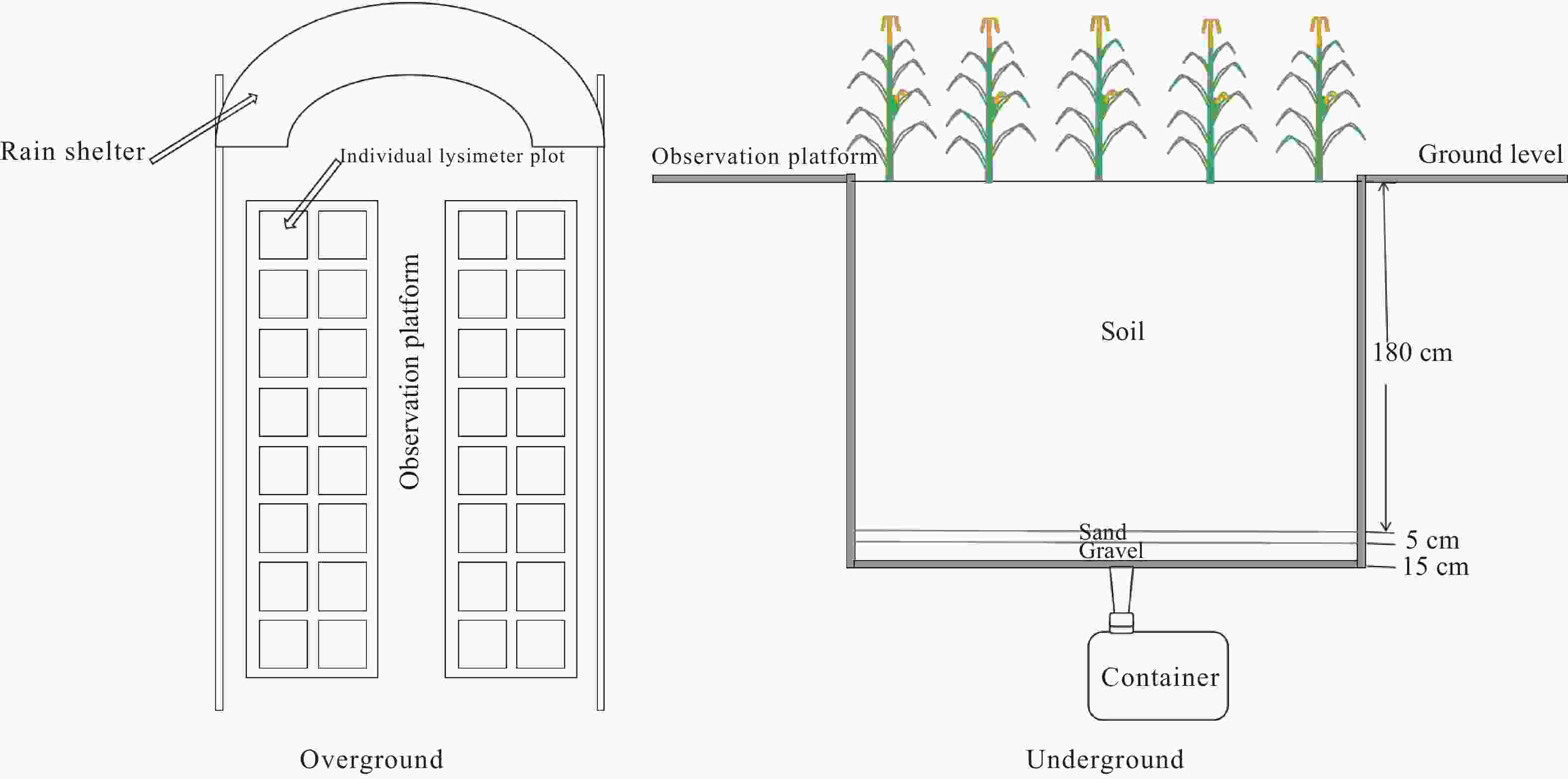
 下载:
下载:
